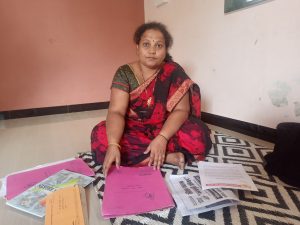Adivasi Women Bear The Brunt Of Slow Community Forest Rights Approvals In Gujarat

It has been years since the women of Bilmarh, a village on a small hillock some 25 km from Ahwa, the district headquarters of Dang district, have had a peaceful night’s sleep.
Every night, they wait in a queue with their utensils, on a patch of land smeared neatly with cow dung overlooking a hand pump and a well, for their chance to fill water. The well remains dry all through the summer. The hand pump is the only source of drinking water for the household as well as the livestock. For other activities like washing clothes and bathing, they have to walk for five kilometres to a river that is partly dry.
The sound of a hand pump with the silhouette of teak forests in the background may either be eerie or musical, depending on the mood and ambience. For these women though, the sound of each stroke of the hand pump is a reminder of the wait for their turn.
“Sometimes, our turn to fill water comes once in three to four days,” says Sakuben Sureshbhai Bhoye, a Dangi Adivasi resident of the village. “Every night, we wait for our turn and only manage to catch some sleep during the wee hours. During the day, since all of us have to carry out household chores, we inform each other of our turns. This has been an everyday affair for years.”
Bhoye and other women of the village were lucky that particular day. Someone from the village down the hill had managed to call for a tanker and was generous enough to share it with the hundred families who live in Bilmarh. But, the rocky uneven access road to the village made it difficult for tankers to reach the village. The local authorities had tried to install a PVC pipe for transporting water, but heat and elevation spoiled that attempt too.
To find a permanent solution to their water woes, the residents of Bilmarh sought a piece of land from the Gujarat government under the Forest Rights Act,2006, to construct an artificial poly pond structure that could store water. The Forest Rights Committee (FRC) of the village, a committee appointed by the Gram Sabha, applied for two different patches of land– one for community activities such as grazing for the livestock and the other for the construction of the artificial pond. Both these demands were rejected on unknown grounds.
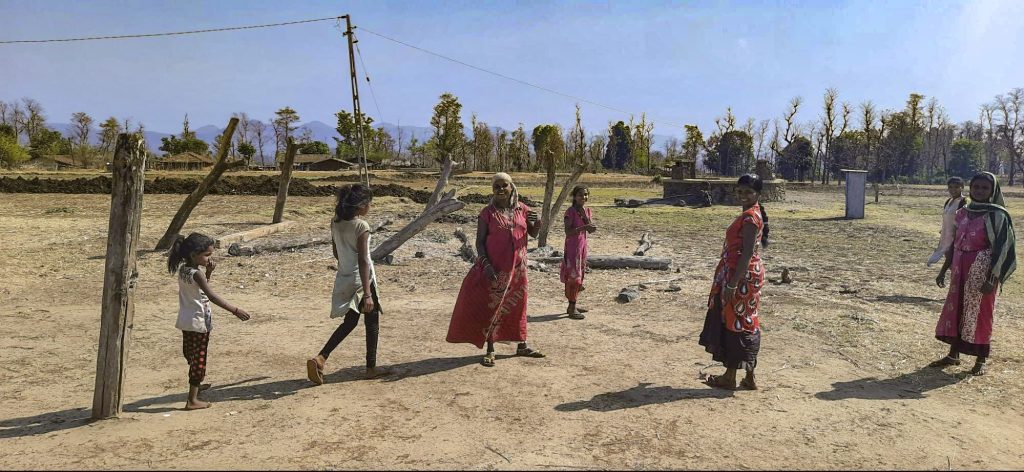
The Forest Rights Act 2006 grants forest dwelling communities, including tribals and other traditional dwellers, rights to community forest resources (CFR) to protect, regenerate,conserve or manage resources which they have been traditionally conserving, for sustainable use. The act gives the rights to the communities to activities such as grazing,fishing, and collecting and preserving minor forest produce. It also gives them the right for developing basic infrastructure, such as schools, health centres, Anganwadis, fair price shops on the forest land.
Sarlaben Prakashbhai Bhoye, another resident of the village, told Behanbox that the FRC had submitted all the necessary documents but they were not informed of the reasons for the rejection. The FRC has appealed against the decision to the District Level Committee (DLC) and is waiting for a verdict.
The Gujarat government received 7,187 claims for 11.61 million acres of land as part of CFR until January 2021, according to data from the Ministry of Tribal Affairs. Less than half (49%) of the titles applied for, have been distributed in Gujarat. Only 46.6% of titles have been approved in the rest of the country.
In the Dang district, 273 out of 311 villages have formed forest rights committees (FRCs). But,only 76 of the villages have got their CFRs recognised, that too partially, since 2016, according to an article in the Down to Earth magazine published in January 2021.
“We are still hoping some good will come out of the appeal (against the rejection) but we don’t know when it will be resolved. Until then, our struggle for access to water continues. We can only pray that the rains are good this year, so we can at least have water in the well,” says Sarlaben.
Behanbox travelled across eight tribal majority districts in Gujarat to understand the impact of the low approval rates of applications of right to community forest resources. We found that the absence of these rights dilutes the ethos behind the FRA and limits its benefit in general, but women suffer disproportionately due to losses in potential economic benefits as well as overall well being.
Gujarat’s Poor Track Record
In Gujarat, the hilly tribal regions spanning from Banaskantha in the north to Valsad in the south and some parts of the western region come within the ambit of the FRA.
The state does not have an encouraging track record in granting approvals for community as well as individual rights to forests. On paper, 49% of the applications have been granted titles– the sixth highest in the country. In reality however, many of these do not hold rights to management of forest or have limited rights.
Some villages reported to have not received the rights to CFR at all or have received for produce that do not even exist on their forest land. In Godhabari village in Navsari district, for instance, the CFR was granted in 2013 but only for collecting forest produce, fuel wood and fishery. The area approved does not have any water body.
In some cases, villages received only limited rights for grazing and collecting fuel wood but not for management and preservation of forest. Godhabarii village can only collect and sell Mahua flowers and Tendu leaves, but cannot grow new varieties of trees or take steps towards preserving the biodiversity. This not only limits their options for income from the forest but also strips them of their rights to preserve traditional knowledge.
“This year we will get less Mahua but we can sell it for a higher price. Besides Mahua, we would have liked to grow mango and Chikoo trees. But we are not allowed to manage the forest but only use its resources,” said Vidya Ullubhai Tokle, a resident of the village. Tokle wants to start a collective for selling minor forest produce in the future. “Women collect the fruits, but they don’t keep the money for themselves in some families. At the end of the day, it becomes family money.”
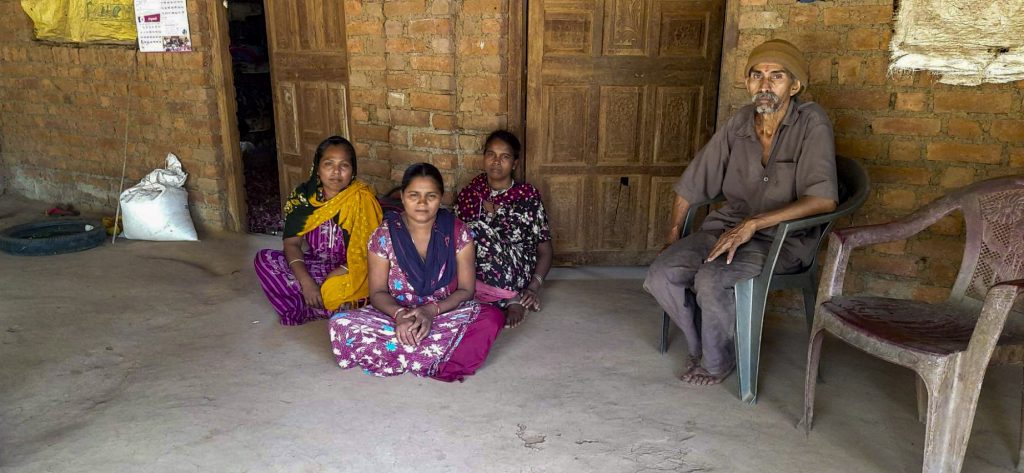
The government of Gujarat, however, denies that the state has lagged behind in CFR approvals.
“Most of the community forest rights claims have been settled and it is in large numbers, I am told”, Jaipal Singh, Gujarat’s Additional Principal Chief Conservator of Forests (Land) told Behanbox. “Many villages have already started reaping the benefits of the sale of forest produce as a community.”

Ambrish Mehta, the trustee at Action Research in Community Health and Development (ARCH) Vahini, a Gujarat based NGO focussed on improving the lives of the tribal population, reckons that most of the CFR claims in Gujarat were filed in 2009-10.
“As large numbers of individual claims (IFR) to land were rejected, the enthusiasm began to taper down. People believe that if individual claims are denied, the government is unlikely to give them forest land for management”, said Mehta. “In the northern districts of Gujarat, the issue of individual rights is not yet settled. In many villages CFR rights have been granted but the residents are not even aware.”
The main obstacle in the effective implementation of the Forest Rights Act is the forest department, said Mehta.
“Government is neither too politically committed but nor opposed to it entirely. The forest department has been creating stumbling blocks all along the process from the very beginning”, Mehta said. “In 2009, only 10% of IFR claims were approved, that too, with truncated land (less area of land than what the villagers sought). It has now reached 45% after a long drawn fight (by people and social organisations). Forest department needs to understand that granting of such rights is beneficial not just for tribals but also for the forests itself. That perception is still not changing.”
Women, who are primary collectors of minor forest produce, often complained about unpleasant exchanges with officials of the department. The forest department also plays a significant role in the process of granting CFR rights to tribals and other traditional forest dwellers.
Women Lose Out
Sambalpani village in north eastern district of Banaskantha has also had its application for CFR rejected for unknown reasons. Rabaris (also known as Maldharis) in the village have been seeking community land for grazing their livestock. Ukkiben Rabari, a Rabari pastoralist, told Behanbox of the many instances where she and other women in her village have come to loggerheads with people from neighbouring villages or with officials of the forest department while taking their animals for grazing in forest areas.
“Humein to kayi baar danda dikha kar bhagate hain ( They drive us out of the forest using sticks),” Ukkiben said.

“Livestock is everything for us. At least in the monsoon months when grass grows in abundance and our men don’t have to travel far away to other villages in search of pastures, we should be able to have access to the forests near our homes. We have lived here for generations, so why is it still not our own?”, she asks.
Ukkiben sells buttermilk, which is her main source of income, in the nearby town of Ambaji during the first half of the day. Access to good grazing land is crucial for her as it ensures more produce and higher income for her to be able to meet her household needs. Ukkiben earns around 250 rupees per day from her buttermilk sales.
Ukkiben is a member of the forest rights committee, since law mandates representation of women, but has herself not taken the lead in the CFR process. But, the course that the CFR approval takes, has a direct impact on her livelihood and well being.
Nafisa Barot, the founder-member of Utthan, a Gujarat-based non-government organisation that works on women’s land rights, believes it is important for women to actively participate in FRC processes and meetings. Not only do women need to be made aware of their rights, but also the process of asserting them in a manner that is beneficial to the community, environment as well as conserving traditional knowledge, she says.
“Denying CFR to a community is a denial of basic human rights, whether or not the financial loss is quantifiable. Regardless of the financial outcome, these rights are necessary ,” said Barot. “ Women should not go through this kind of drudgery. With the time they are able to save, they may just spend it on themselves and their well being and not necessarily to generate income. So, it is a basic right, period.”
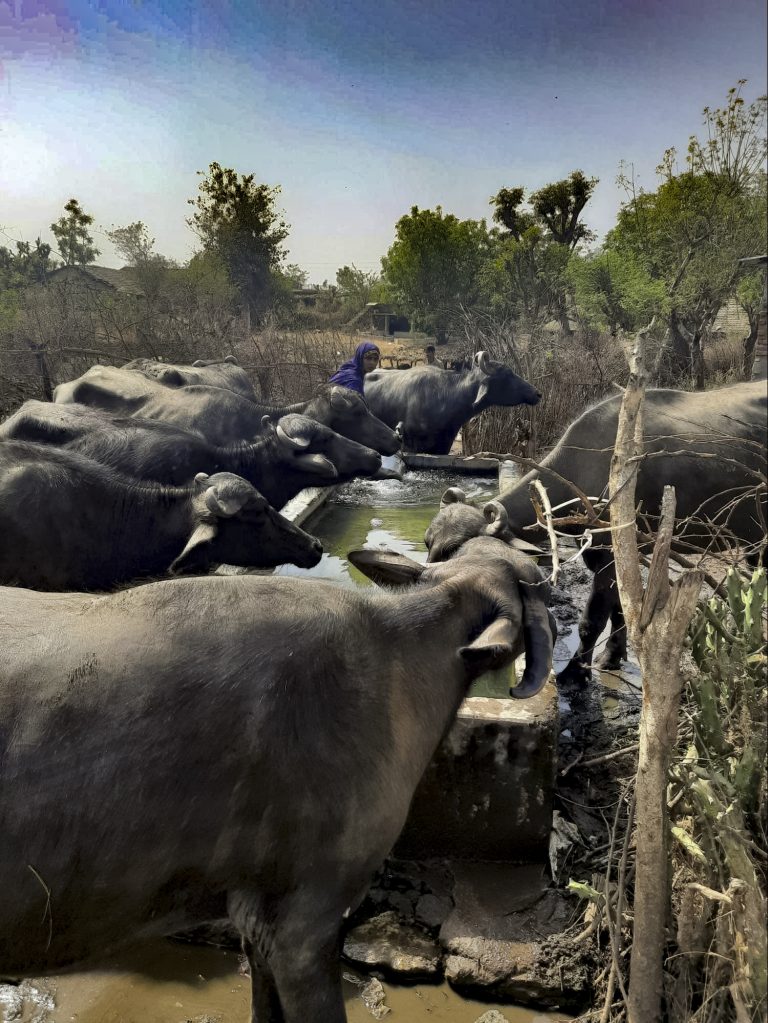
Even then, minor forest produce is a big income generator. During the year ended March 2020, the total procurement of minor forest produce through both Government and private trade crossed 20 billion rupees, according to government data. Gujarat procured 155 metric tonnes of MFPs worth 161 million rupees, much less than 20,270 metric tonnes of MFPs worth Rs 528.0 million rupees in Chhattisgarh and 9908 tonnes of MFPs worth 213.2 million rupees in Odisha. The Gujarat Forest Development Corporation claims that currently over 75 MFPs are being collected, which translates into higher income for tribals close to the homestead during the lean season. The Corporation pays over 100 million rupees annually to primary collectors for procurement, which in turn, provides two million employment days in rural and forest areas. Gujarat, primarily an industrial state, had an estimated Gross State Domestic Product (GSDP)of 18.79 trillion rupees ($ 259.25 billion) in FY22, an increase of 7% YoY.
When Women Lead
Narmada district is a rare example of successful implementation of community forest rights where women have taken the lead.
The district is home to the Pragati Mahila Van Samiti, one of the very few women led CFR groups in the state. The Samiti, headed by Ramilaben Mansukhbhai Vasava, a Bhil Adivasi woman, has received approval for 50 hectares of land near Navgaon village on the Saurapara forest range in the district. As a member of a local non-governmental organisation and a trained paralegal in forest rights, the process was easy for her to understand.
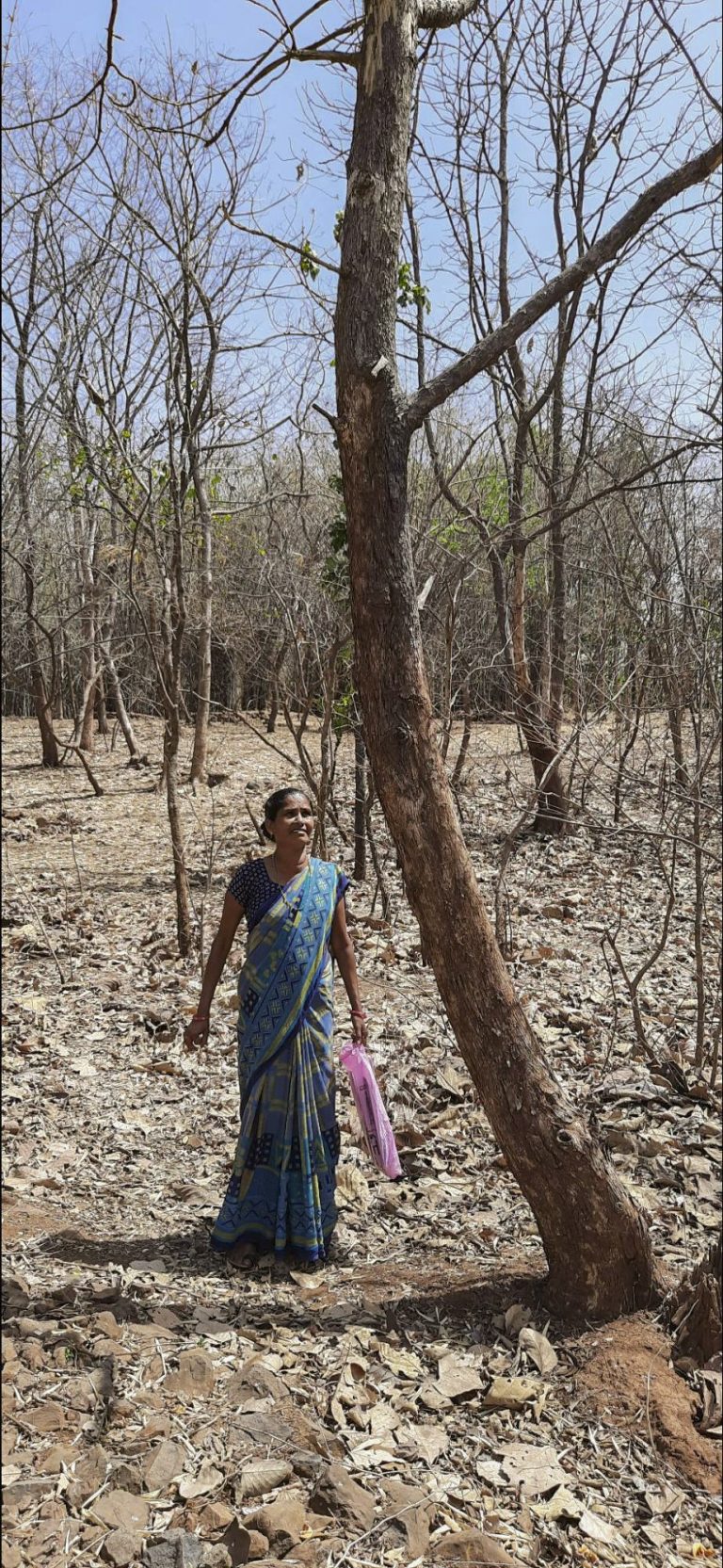
A women-led CFR group gives women the sole power to manage and utilize forest resources in a way that would benefit them directly. In a patriarchal society, such groups have the power to decide on the ways to manage the forests, trade produce,and build infrastructure such as Anganwadi or public toilets for the convenience of women.
Vasava and her comrades in the Samiti have created a vibrant forest management and preservation culture. They have constructed stone bunding structures to control erosion of slopes during the monsoon season which gave employment to the residents under the MNREGA . They have managed to persuade the authorities to construct a small dam on the river stream to cultivate fish and use the water for general purposes. From the forests, they can take wood for kitchen fuel, medicinal plants for personal use, and Tendu leaves for trade.
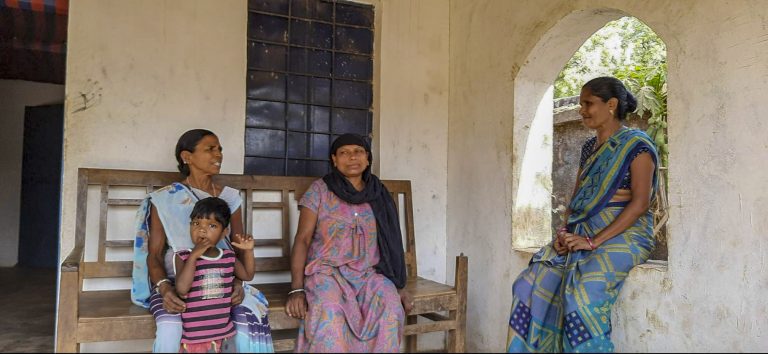
The Samiti created a roster of a team of five women who guard their forest land from encroachers and illegal wood smugglers. In one incident during the last monsoon season, the samiti had blocked an attempt by members of the neighbouring village who were encroaching upon their land. Women on the evening patrol alerted the others by beating steel plates. A brawl ensued and the case is now in court.
“The very fact that we have a say is an empowering feeling”, said Vasava. Besides, she said, it has helped in improving the financial conditions of many women and families. The samiti is now growing custard apples and has tied up with a company to supply the produce on a regular basis.
In some other areas where CFR has been successfully implemented, residents have been able to tie up with manufacturers in the area. In the Dangs, for instance, around 20 Gram Sabhas signed a memorandum of understanding (MoU) to supply bamboo to the Central Pulp Mill. They have earned a revenue of around 600,000 rupees according to estimates by local activists. Earlier, companies would procure bamboo directly from the forest department, leaving villagers out of the process. The process of review of rejected claims, truncated land claims, as well as limited rights doled out under the CFR may take years to resolve. In the meanwhile, women are losing out on opportunities that can improve their quality of life and their rights.
As a woman, from among the crowd that gathered to share their story of struggle for water in Bilmarh village said: “I would rather be out selling farm and forest produce in the market and making some extra money for my family than sitting here and waiting for my chance to fill water”
[This reportage is part of the WGWLO and Behanbox fellowship on women’s land, forest and farming rights in Gujarat]
We believe everyone deserves equal access to accurate news. Support from our readers enables us to keep our journalism open and free for everyone, all over the world.


